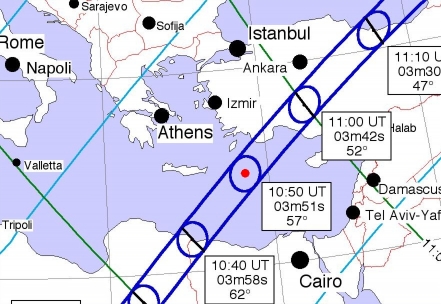
This is my first total eclipse, and probably won't be my last! The eclipse occurred off the coast of Greece, so even if the weather had been cloudy, my wife and I would still get a good vacation and cruise experience. We were advised to not attempt photography during our first experience, but I had to try something. I used a handheld Panasonic Lumix DMC-LX1 camera with slow internal image stabilization to help compensate the ship's motion on the longer exposures. The longest effective focal length was only 112 mm (35 mm equivalent), so the sun was only about 100 pixels across, but I predicted that this would be adequate to show enough detail to help remember the experience, without using a telescope or more elaborate setup.

The cruise ship Ocean Monarch (chartered by Astronomical Tours) was stationed just at the red dot in the figure above (from Eclipse Predictions by Fred Espenak, NASA/GSFC). The seas were pretty calm, and only light clouds surrounded the sun, so the conditions were pretty good. David Levy was the eclipse announcer on board.
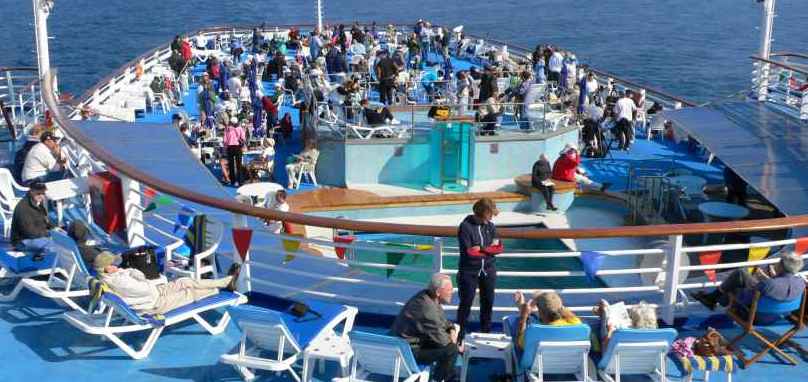
Even four hours before totality, many of the viewers already staked out their locations. Luckily, there was plenty of room on the decks for everyone.
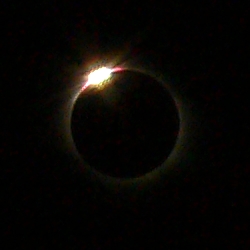
The Diamond Ring was captured just at second contact. We had just removed our glasses a few seconds earlier. I had set the camera for its minimum exposure, and was a good guess (1/1000 at F/8). It looks like the Diamond Ring had some ruby stones nearby.
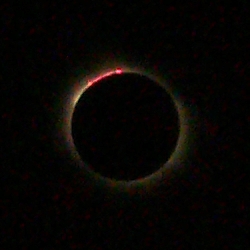
The largest prominences were seen on the same side that the moon last covered. At the same minimum camera settings, the prominences were pretty dim and the corona non-existent. (+15 sec)
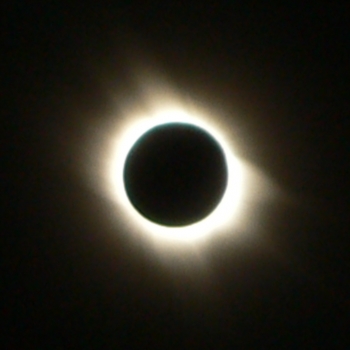
After observing the wispy, very-fine structured corona with the naked eye and binoculars, the camera was set at the longest exposure that I could tolerate, and took a few more photos. To reduce noise, two consecutive images were combined to get the figure above. The fine structure is not seen, due both to the resolution limit and the image motion. [F/4.9, 1/20 sec] (+138 sec, +147 sec).
The lunar disk was much darker than I expected, like looking into a black hole. The corona was stationary, but the wispy, feather-like detail made it look like it was in motion. I did not notice the prominences or any color, so I am glad that I took these few photos. Venus was obvious a little before totality, but I forgot to look for Mercury or stars. It was not so dark on the ship - it would have been easy to read a book, for example. The length of the eclipse was enough to do this simple photography as well as look through binoculars.
Just 160 seconds after totality ended, the skies seemed to get cloudier. Maybe the 16 F drop in air temperature made the clouds appear, but maybe we were just a little lucky.

Only 6 minutes after totality ended, most of the participants were walking around, essentially ignoring the rest of the eclipse. We had no problem getting our picture taken. The sun was still just a thin sliver in the sky (8% of the diameter showing), but there was plenty of light.
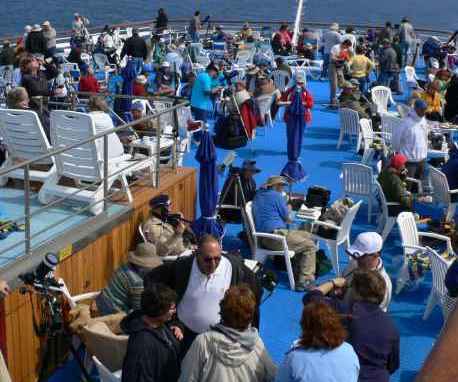
David Levy (white shirt, dark jacket at bottom center) announced the major events, but 40 minutes after totality, there wasn't a whole lot more to announce. Dava Sobel (in hat just left of Levy) was a surprise guest on the cruise (author of several very popular historical science books, including "Longitude" and "Galileo's Daughter").
Click here to go to the first part of our vacation in Athens and Delphi,
or click here to see our vacation pictures of some of the Greek islands and Ephesus.
Click here to return to Don's personal pages.
All text and images Copyright by Stellar Products, 2006. Any use by others without permission of Stellar Products is prohibited.
Links to other Stellar Products pages: